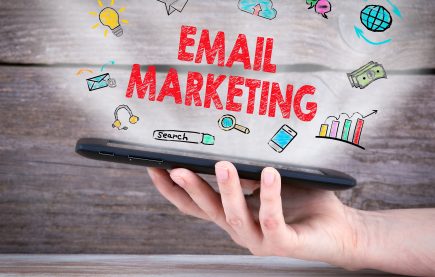
How to Create a Website Conversion Funnel & Why It Matters for Your Business
The moment you set up a website that leads to a conversion, you have created a funnel, possibly without even realising it. However, Econsultancy says only 22% of businesses are satisfied with their conversion rates. If you fall into the other 78%, your conversion funnel may be the problem.
A well-optimized conversion funnel will help you maximize profit from your marketing campaigns. As with all marketing endeavors, optimizing your funnel takes time and effort. Read on to learn all about conversion funnels, why they matter, and how to create one that works.
What is a website conversion funnel?
To put it simply, a conversion funnel is a visualization of the path that takes a person from prospect to customer. Your leads can come from many different sources including content marketing, social media, and cold email outreach. Understanding your funnel will give you a better idea of how to convert more of those leads into customers.
What are the parts of a conversion funnel?
There are many different versions of the conversion funnel, and each business uses them slightly differently. However, in its most basic form, a conversion funnel has four key steps: awareness, interest, desire, and action.
Source: Vecteezy
Awareness
Brand awareness is critical, even if your company is already quite well known in its niche. Building awareness involves reaching new audiences who would otherwise be in the dark about your business and its products or services.
You can use a variety of channels to pull leads into your funnel. Social media marketing, boosting your SEO for organic search, and pay-per-click advertising are just some of the most common and effective. Which strategies work best for you will depend on your business and customer base. Focus on quality over quantity.
Interest
Once your prospects are aware of your business, you need to build their interest in your products or services.
You can use content marketing to address your prospects’ pain points and establish your brand’s credibility as a source of authoritative information. Providing a steady stream of great content nurtures the relationship and builds trust.
At this stage, you’ll ideally get the prospect onto your email marketing list. Here’s how to do that:
-
Offer a lead magnet in the form of exclusive content or another beneficial bonus in exchange for the prospect’s email address.
-
Send them to a landing page where they can sign up and then download the promised content.
-
Check their email address is genuine using email verification.
-
Start sending them regular email newsletters and content created just for your subscribers.
During the interest phase, you want to show the value you can provide to your customers. This will help keep them moving through the funnel to the next stage.
Desire
At this stage, your prospective customer is interested in your company and its products or services. Now you need to make them want to buy.
Do not make the mistake of trying to do a hard sell. This approach doesn’t work and will just annoy the customer. Instead, nurture them and nudge them gradually in the right direction. At this stage, you might introduce bonuses or use an email drip campaign.
Focus on showing that you can solve actual, real-life problems that your prospects have. White papers, case studies, and testimonials can help at this stage. Remember, you are not selling a product, you are selling a solution to a problem. Once the customer is sold on the solution you’re offering, they’ll be spurred into action.
Action
All the work you’ve poured into the funnel culminates in this phase. Your leads have become aware of your brand, built interest in your products, and come to desire the solution you’re offering. All you need to do now is nudge them into taking that last step and clicking the “Buy Now” button.
You may consider offering a generous bonus or discount to sway those who are still on the fence about purchasing.
Only a small percentage of your initial leads will ever get to this point. That’s normal and to be expected. However, you can improve on that figure by optimizing the rest of the funnel.
How to create an optimized website conversion funnel
Creating an effective website conversion funnel doesn’t happen instantly. It might take some trial and error to find the funnel system that leads to conversions. You’ll need to optimize your funnel at every stage to attract more website visitors, turn them into leads, and eventually convert them into paying customers.
The steps below will help you improve your conversion funnel and increase your chances of making the sale.
Step 1: Create a customer journey map
A customer journey map will help you identify the key decision points a prospect goes through as they interact with your brand. It takes into account the multiple “micro-conversions” that eventually lead to a purchase. These might include steps like searching for and finding a product on the company page, sorting products according to their review scores, and signing up for a free trial.
As you build your funnel, you’ll need to consult your customer journey map and incorporate each of the small decisions that a prospect makes along the way to becoming a customer.
Step 2: Set up your conversion goals
As you create and optimize your funnel, you’ll need a way to measure how well it is working. Google Analytics provides an easy way to establish and track these metrics. First, find the Conversions menu at the left side of your Google Analytics screen, then click “Goals”:
Next, click on “Overview”, “Set up goals”, then “New goal”:

Google Analytics allows you to create up to 20 goals, all customizable according to your chosen parameters:
I recommend starting with the simplest goal: the number of customers who get to the “Thank You” page after a conversion. You could also use customers clicking through to the “Contact Us” page as a goal, but this metric can be somewhat unreliable as many of those people won’t end up sending a message.
Once you’ve set up your first goal, you can consider others. Useful goals might include the average duration of a visit to your website, specific actions like watching a video, or the pages viewed per session.
Remember: you won’t get usable data right away. Give Google Analytics a bit of time to gather a large enough data set to offer accuracy.
Step 3: Use content to stir up interest
Your product might be amazing, but creating great site content will strengthen your offer and produce higher conversion rates. Your customers need to know more about your company, your products, and your solutions.
There is no one-size-fits-all approach to site content. The effectiveness of each medium will depend on your niche and which stage the customer is at in the funnel. By providing quality content, you keep prospects returning to your site and prove that you can be trusted as a source of authoritative information.
Here are just a few of the offers and types of content you can use as customers move through the funnel:
Source: CrazyEgg.com
Aim to create content will entice visitors to your site. This will push them further into the funnel, and increases their chances of converting into customers.
Step 4: Identify gaps in your conversion funnel
If you’re still not seeing the results you’d like, your conversion funnel may be suffering from a leak. The average online conversion rate is between 2.8% and 6%, depending on the industry. Considering those small numbers, funnel leaks can add up to a lot of potential revenue lost.
Each step of the funnel will weed out the leads that aren’t really interested, while those who are qualified will move through to the next step. A leak in the funnel is where a lead who otherwise might have become a customer ends up dropping out for a reason other than lack of interest.
It’s your mission to discover those individuals’ reasons for leaving the funnel. Page loading speed is a big culprit. Did you know, for example, that 53% of internet users leave a page if it doesn’t load within 3 seconds? Here are some other possible causes of leaks that you’ll want to look out for:
-
Your product copy is poor.
-
Your page design is not mobile-responsive.
-
There are negative reviews of a product.
-
Shipping is too expensive.
-
The checkout process is too laborious.
-
You only accept limited payment methods.
Once you identify the cause of funnel leaks, you can begin to fix them.
Step 5: Use CRO to increase conversions
If you’re not sure how to optimize your site to increase conversions, consider using a heatmap. This useful strategy identifies areas of your site that visitors linger on or click on the most. Here’s an example using CrazyEgg’s heatmap tool:
The glowing spots over the menu bar and the email opt-in form indicate that the page is quite effective in getting email list subscriptions. Now, let’s look at a page that isn’t faring so well:
Aside from the navigation menu at the top of the screen, the clicks are scattered This indicates that site visitors don’t really know what to do with the page. This indicates a problem with the design or layout.
Once you know how your site is performing, you can focus on optimizing the areas you’d like people to click. Aside from heatmaps, you can also use surveys to ask would-be customers about what keeps them from making a purchase.
After identifying problems, you can make changes to optimize your site. Here are some of my top conversion rate optimization (CRO) tips you can implement:
-
Make sure your product copy is as good as it can be.
-
Simplify your site’s layout and navigation.
-
Use compelling headlines and calls to action (CTAs).
-
Optimize your site for mobile users.
-
Improve your page speed.
-
Display testimonials.
-
Use an attractive color scheme and easy-to-read fonts.
Don’t be afraid to try things out. By running A/B tests, you can determine the impact of your changes and determine which ones are most effective. Optimizing websites to drive up conversions is a process of trial and error. But with continuous testing and improvement, you can transform your site into one with better conversion rates.
Step 6: Create additional offers
Many prospects who drop out of the funnel simply aren’t qualified leads. Your products might be out of their price range or not meet their requirements. However, you should still take every step you can to overcome sales objections and encourage prospects to convert.
If you encounter a lot of objections based on price, you may consider offering a cheaper variation of your product with fewer features. Creating different products at various pricing tiers makes your offering more attractive to a greater number of people.
You can also offer limited time discounts, free trial periods, or enticing bonus offers to encourage leads to click the all-important “buy now” button.
Step 7: Attract visitors who are more likely to make a purchase
Before you can start pushing people through the various stages of your marketing funnel, you need to ensure you’re attracting the right people. In other words, you need to fix the “awareness” step of your funnel to bring in those who are likely to make it to the end of the process.
Check out the Acquisitions tab in Google Analytics to identify your best sources of traffic:
Remember: high traffic doesn’t automatically result in high conversions. As you can see in the right side column of the above screenshot, organic search brings in the highest number of leads, but results in the lowest conversion rates. You should focus your attention on the longest blue line in the right hand column. In other words, where does your highest converting traffic come from?
You can use the “All Traffic” report to see those “Other” sources broken down:
Once you know which sources of traffic yield the highest conversion rates, you can craft a marketing strategy that focuses on those sources. This will maximize the number of site visitors that make it all the way through to the point of making a purchase.
Step 8: Automate your lead and customer retention
Email marketing is one of the most efficient and effective ways of retaining leads and customers. Once you have a prospect’s email address, you have the chance to convert them into a customer.
Your email marketing campaign might start with a weekly or monthly newsletter containing helpful tips, product information, industry news, and so on. However, as customers move further down the funnel, you’ll need to add other strategies.
Email drip campaigns are ideal for communicating with different groups of customers.These automated email series are highly targeted and designed to move prospects through to the next stage of the funnel.
Here are some examples of drip campaigns you might use:
-
Welcome campaign for new subscribers.
-
Abandoned cart sequence (for those who put items in their shopping cart but didn’t check out).
-
Limited time special offer campaign.
-
New product launch announcement campaign.
-
Continuing the relationship with a customer after a purchase. Studies show that it’s 60%-70% easier to sell to an existing customer.
And so on. The point of drip campaigns is to slowly build interest and gently push your prospects in the right direction.
You can automate the various steps in your drip campaign using email analytics, based on how the recipient reacts to previous emails. For example, if they respond positively to a specific kind of content, you can send them more similar emails. Everything should be specific, highly targeted, and designed to address needs and pain points.
Bringing It All Together
If you have a website where you want visitors to take a specific action, you already have a conversion funnel of sorts. However, most conversion funnels are poorly optimized or not optimized at all, leading to lost opportunities and lost revenue.
By optimizing your funnel, you decrease leaks and make sure that as many people as possible make it to the final “Action” stage. So follow the steps I’ve outlined for you, and study your site and audience closely to figure out what’s working and what isn’t.
Try things out and remember to monitor your metrics at every stage. If you stick with it, you’ll soon start seeing those higher conversion rates!
Bio
Owen Baker is a content marketer for Voila Norbert, an online email verification tool. He has spent most of the last decade working online for a range of marketing companies. When he’s not busy writing, you can find him in the kitchen mastering new dishes.


